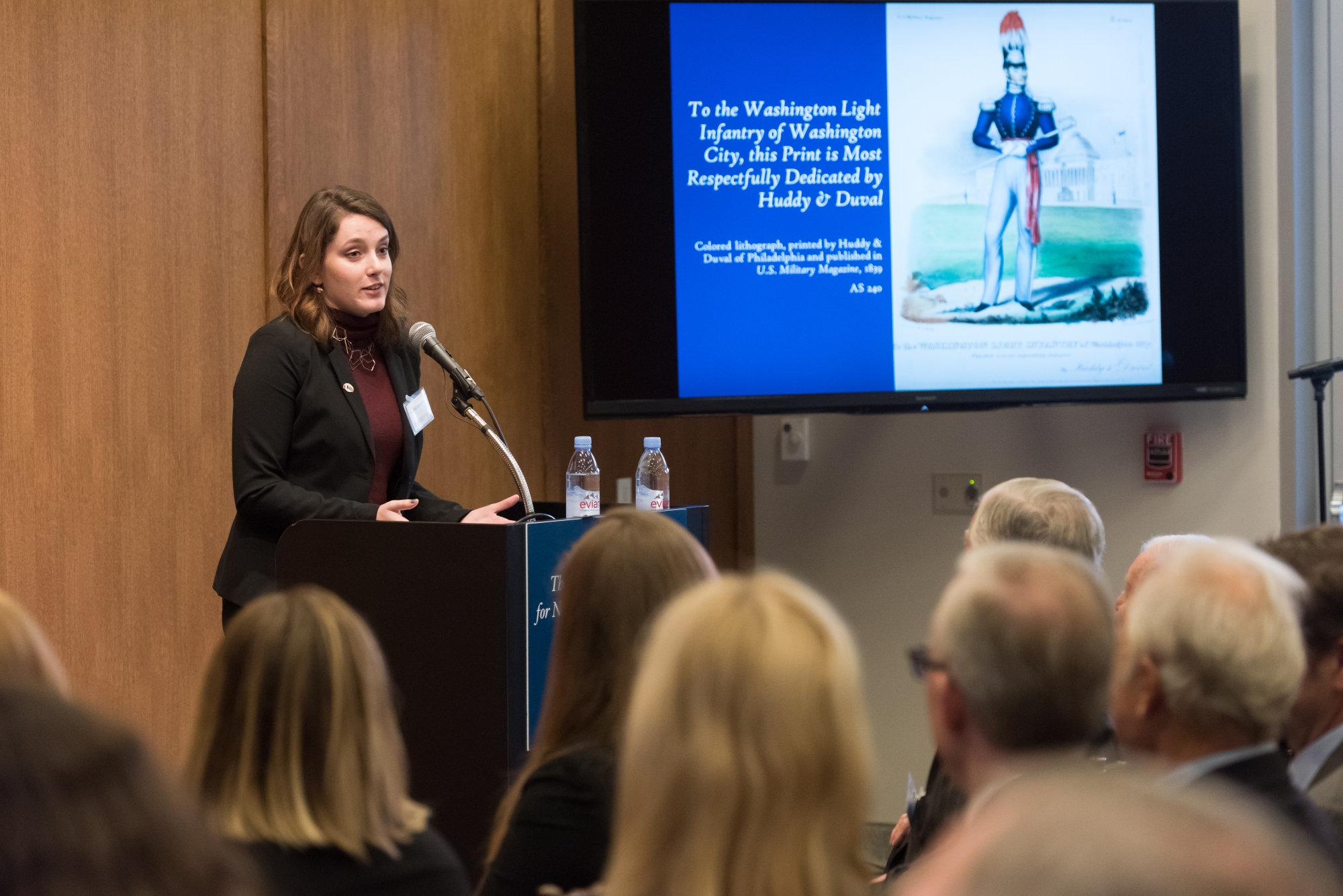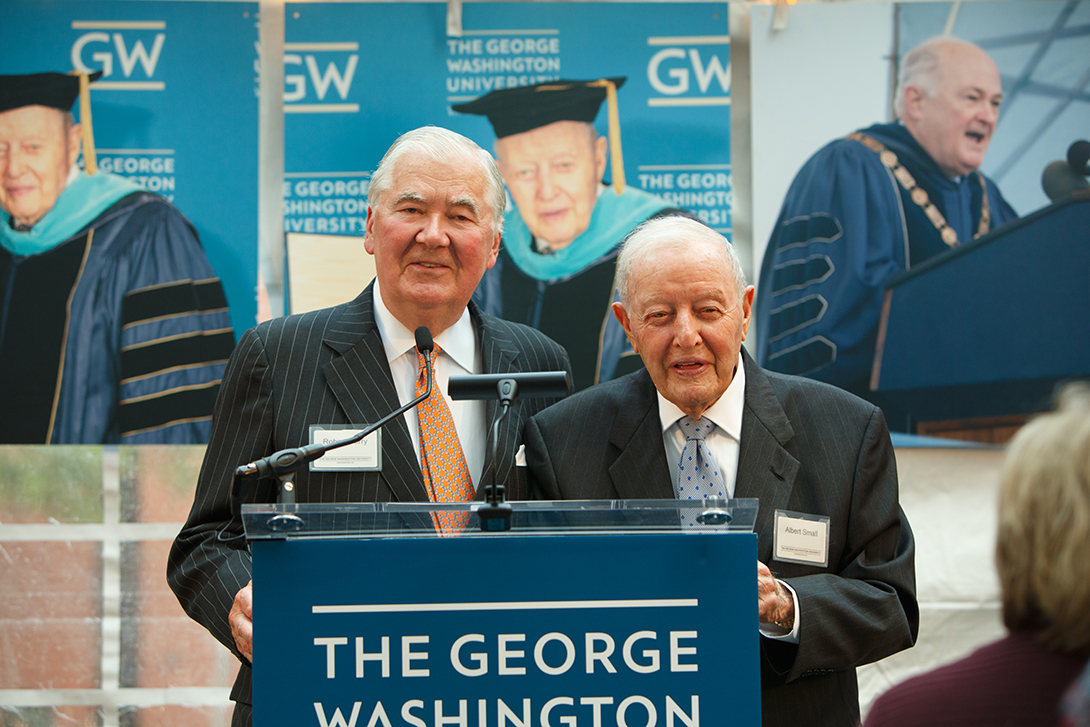By Kristen Mitchell
Sophomore Julia Brown said a 1859 print of George Washington’s beloved Mount Vernon estate taught her an important lesson about the work that goes into preserving America’s history. History cannot be taken for granted, and it does not create itself, she said.
Two generations after Mr. Washington’s death, a group of Virginia women banded together to raise money to restore the decaying Mount Vernon to its former glory for future generations to enjoy. An artist depicted the restoration efforts in a print, preserved in the Albert H. Small Washingtoniana Collection housed at the George Washington University Museum and The Textile Museum.
“The incredible efforts of these ladies inaugurated a centuries-old tradition of not only preserving George Washington’s legacy but also educating today’s Americans on the history of their nation and the life of one of its greatest men,” Ms. Brown said.
Ms. Brown researched and presented on the print’s rich history at the seventh annual Albert H. Small Washingtoniana Symposium Tuesday. She was one of four students to showcase how they use the Washingtoniana Collection for research.
The Washingtoniana Collection is full of rare maps, drawings, letters, books and other documents relating to the history and evolution of Washington, D.C. Albert Small donated his collection to the George Washington University in February 2011 to help establish the George Washington University Museum on the Foggy Bottom Campus.
Bob Perry, special adviser to the GW Museum and a former university trustee, said the Washingtoniana Collection is an incredible asset for the university. The ability to use primary sources for research gives students an unparalleled opportunity for learning.
“He wants future generations to see what he has collected over 60-some years of his life, and this symposium reinforces Albert’s desire that younger generations understand the history of his country and this city,” he said.
George Washington President Thomas LeBlanc thanked Mr. Small for his dedication to deepening the nation’s understanding of history and culture through his collection. The collection is instrumental to educating future museum professionals at GW, he said.
“The experiential learning it produces for our students and our community is truly a unique asset,” Dr. LeBlanc said. “I’m grateful to be part of this special community and indebted to the ardent supporters of this institution like Albert.”

Andrea Marshall, B.A. ’15, M.A. ’17, gives a presentation on a lithograph of an American soldier. The piece is from the Albert H. Small Washingtoniana Collection. (Photo: Dave Scavone)
Students investigate the history of pieces in the Washingtoniana Collection, prepare a 50-word description of the items for display in the museum and present their findings at the symposium every year.
Kathryn White, a graduate student in the museum studies program, researched a mezzotint of Mr. Washington and his family created in 1864 called “Washington and His Family.” The print is similar to a famous painting created in Mr. Washington’s lifetime, but is different in significant ways that reflect the changing times. The mezzotint has a more informal backdrop and was popular in both the North and South during the Civil War.
“The differences held some symbolism for the changing values over time in a way that George Washington acted as a symbol in the United States,” she said.
Junior Bella Bucchi, who is majoring in history and art history, studied a woodcut of Arlington House at Arlington Cemetery published in 1886 by Harper’s Weekly. The house was once owned by relatives of Mr. Washington, but is better known for its connection to Confederate States of America General Robert E. Lee. Mr. Lee lived in the house prior to the Civil War, during which it was seized by the United States government, and the land was used as a Union cemetery.
Ms. Bucchi said there is debate in historical circles about who should be associated with Arlington House, Mr. Washington or Mr. Lee.
“Reconciling today’s values with historical representations of figures, or in this case, everything that is associated with Arlington House, is something that we still consider today,” she said.
Andrea Marshall, B.A. ’15, M.A. ’17, researched a lithograph of an American soldier with the U.S. Capitol in the background. The print is dedicated to the Washington Light Infantry of Washington City, however, research shows the Washington Light Infantry was a South Carolinian unit.
The dedication was likely a misunderstanding made by the printmakers, a French artist and a Philadelphia native. This exercise demonstrated one of the challenges of studying history—historians often don’t consider human error, Ms. Marshall said.
“It’s ironically fitting that they chose the U.S. Capitol,” Ms. Marshall said. “After all, that’s what the building symbolizes, the union of otherwise different locations, customs and people brought together by a common desire to create a whole that is better and stronger than its parts.”
In addition to the research resources, the Albert H. Small Center for National Capital Area Studies offers programs like the D.C. history lecture series at noon on Mondays and internship opportunities.
Attendees toured the museum and celebrated Mr. Small’s 92nd birthday at the symposium. Last year, GW awarded Mr. Small an honorary Doctor of Public Service degree. Tuesday the university unveiled a portrait of Mr. Small to be hung in the historic Woodhull House, part of the museum.
Mr. Small said he was pleased to celebrate the occasion with family and friends.
“My life is right here, and I’m so happy that everybody comes to celebrate my birthday, it’s very nice,” he said. “Thank you so much.”



